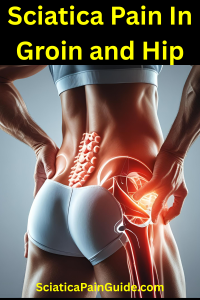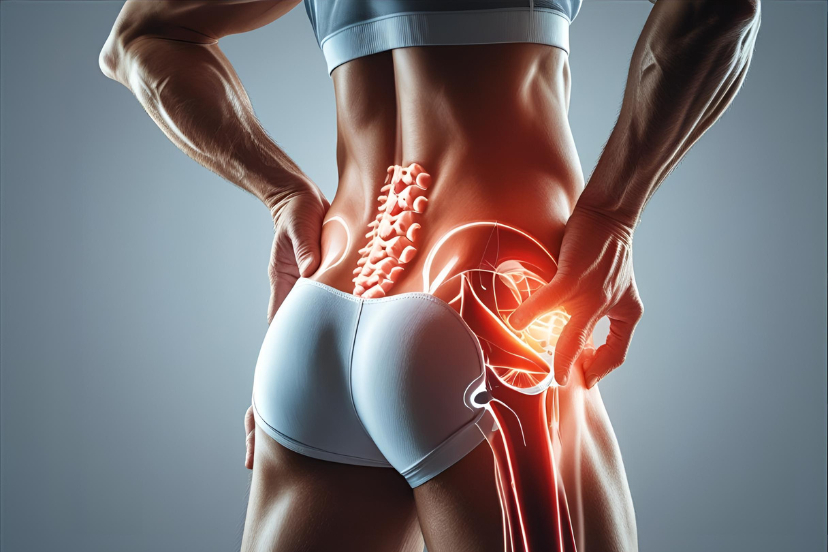Sciatica Pain in Groin and Hip
Sciatica pain is often associated with discomfort in the lower back, buttocks, and legs. However, some people also experience sciatica pain in groin and hip — a symptom that can be confusing and alarming. While not every case of groin or hip pain is sciatica, nerve irritation or compression can sometimes radiate into these areas, affecting mobility and quality of life.
In this guide, we’ll explore why sciatica can cause groin and hip pain, how to tell it apart from other conditions, and the best treatments for relief — including home care, medical options, and prevention tips.
Sciatic pain in the groin and hip
Sciatica pain in the groin and hip can be frustrating and limit daily activities. This guide explains why sciatica can cause discomfort in these areas, the common underlying causes, and how to tell it apart from other conditions. Discover effective home remedies, targeted stretches, posture tips, and lifestyle changes that can ease pressure on the sciatic nerve and promote long-term relief.
Learn when to seek medical attention, how diagnostic tests can pinpoint the source, and which treatments—from physical therapy to medications—are most effective. Whether your pain is sharp, burning, or radiating, this comprehensive resource offers practical advice to manage symptoms and support recovery naturally. Improve your mobility, reduce flare-ups, and take steps toward living pain-free with these evidence-based strategies for managing sciatica in the groin and hip.
Understanding Sciatica and Its Unusual Pain Patterns
Sciatica occurs when the sciatic nerve — the longest nerve in the body — is irritated, inflamed, or compressed. This nerve runs from the lower spine, through the buttocks, and down each leg. The pain is typically felt along the nerve pathway, but depending on which nerve roots are affected, symptoms can spread to unusual places, including the groin and hip.
Groin pain in sciatica is less common than thigh or calf pain, but it may happen if:
-
The upper lumbar nerve roots (L2–L3) are involved
-
There’s referred pain from nearby muscles and joints
-
Inflammation affects multiple nerve pathways
Common Causes of Sciatica Pain in the Groin and Hip
Not all groin or hip discomfort is caused by sciatica — but when it is, these are the most likely reasons:
1. Herniated or Bulging Discs
A damaged spinal disc in the lumbar region can press on nerve roots that also send signals to the groin and hip area.
2. Spinal Stenosis
Narrowing of the spinal canal can irritate nerves, causing radiating pain into the front or side of the hip and sometimes into the groin.
3. Piriformis Syndrome
The piriformis muscle, located deep in the buttock, can compress the sciatic nerve, potentially creating referred discomfort toward the groin and hip.
4. Sacroiliac Joint Dysfunction
Irritation of the sacroiliac joint (where the spine meets the pelvis) may mimic sciatica symptoms and cause pain in the hip and groin.
5. Muscle Imbalances and Posture
Tight hip flexors or weak gluteal muscles can alter body mechanics, irritating nerves and creating pain patterns that reach the groin.
Symptoms to Watch For
When sciatica pain affects the groin and hip, you may notice:
-
Sharp, burning, or shooting pain from the lower back into the hip/groin
-
Tingling or numbness in the inner thigh or groin
-
Muscle weakness in the legs or hips
-
Pain worsens when sitting, bending, or twisting
-
Relief when lying down or changing position
If pain is accompanied by loss of bladder or bowel control, severe weakness, or sudden numbness, seek medical attention immediately — these could be signs of a medical emergency.
Diagnosing Sciatica-Related Groin and Hip Pain
Because groin pain can result from multiple conditions — including hernias, hip arthritis, or gynecological/urological issues — proper diagnosis is critical.
Your healthcare provider may use:
-
Medical history and symptom review
-
Physical examination to check nerve function, reflexes, and mobility
-
Imaging tests like MRI or CT scans to look for nerve compression
-
Nerve conduction studies to assess signal flow
Home Remedies for Relief
For mild to moderate sciatica-related groin and hip pain, home treatments can help reduce inflammation and promote healing:
1. Heat and Cold Therapy
-
Apply ice packs for 15–20 minutes during the first 48 hours to reduce inflammation.
-
Switch to heat packs or warm baths to relax muscles and improve blood flow.
2. Gentle Stretching
-
Hip flexor stretches
-
Piriformis stretch
-
Knee-to-chest stretch
These help relieve tension and reduce nerve irritation.
3. Low-Impact Exercise
Walking, swimming, or stationary cycling can keep blood flowing to the affected area and prevent stiffness.
4. Posture Correction
Maintain an upright sitting position with lumbar support to reduce pressure on the sciatic nerve.
5. Over-the-Counter Medications
NSAIDs (like ibuprofen) can reduce inflammation and ease discomfort, but always use them as directed.
Medical Treatment Options
If home care isn’t enough, your doctor may recommend:
-
Physical therapy to strengthen core and hip muscles
-
Prescription medications for nerve pain
-
Corticosteroid injections to reduce inflammation near nerve roots
-
Chiropractic adjustments for spinal alignment
-
Surgical options in severe cases of nerve compression
Preventing Sciatica Pain in the Groin and Hip
Preventive measures can reduce the risk of recurrence:
-
Stay active with regular stretching and strengthening exercises
-
Maintain a healthy weight to reduce strain on the spine and hips
-
Practice safe lifting techniques
-
Use supportive seating for long periods
-
Address posture imbalances with ergonomic adjustments
When to See a Doctor
Seek medical advice if:
-
Pain persists for more than two weeks without improvement
-
You notice worsening numbness or weakness
-
Pain interferes with walking or daily activities
-
You develop sudden bladder or bowel issues (emergency)
Early diagnosis and treatment improve the chances of recovery and prevent permanent nerve damage.
FAQs About Sciatica Pain in the Groin and Hip
1. Can sciatica cause groin pain?
Yes, if the upper lumbar nerve roots are affected, pain can radiate into the groin.
2. How do I know if my hip pain is from sciatica?
If pain is accompanied by lower back discomfort, tingling, or numbness, and worsens with specific movements, it may be sciatica-related.
3. What’s the difference between hip arthritis and sciatica?
Hip arthritis is a joint-related condition, while sciatica originates from nerve compression in the spine.
4. Can piriformis syndrome cause groin pain?
In rare cases, yes — referred pain can travel toward the groin and hip.
5. Is walking good for sciatica in the hip and groin?
Yes, gentle walking can promote circulation and reduce stiffness.
6. Should I avoid exercise if I have groin pain from sciatica?
Avoid high-impact or twisting exercises, but gentle movement is beneficial.
7. When should I get medical help for sciatica groin pain?
If pain worsens, lasts more than two weeks, or is accompanied by severe symptoms like weakness or bladder issues, see a doctor immediately.
Final Thoughts on Sciatica Pain in Groin and Hip
While sciatica pain in the groin and hip is less common than in the legs, it can be just as disruptive. Understanding the connection between nerve pathways and these areas is key to effective treatment. With a combination of home remedies, medical care, and preventive strategies, most people can find lasting relief and return to normal activities.
Disclaimer:
This article is for informational purposes only and is not intended to replace medical advice. Always consult with a licensed healthcare provider or acupuncturist before starting any new treatment.






